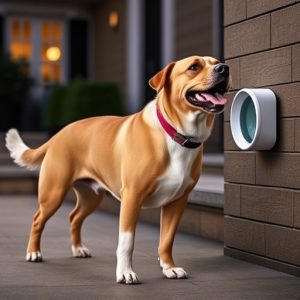Secure Your Home: Motion Sensors & Barking Dog Alarms for Ultimate Protection
Motion sensor barking dog alarms are advanced home security devices that use PIR and microwave techn…….
Motion sensor barking dog alarms are advanced home security devices that use PIR and microwave technology to differentiate between humans, pets, and objects, minimizing false alarms. They monitor heat signatures and electromagnetic fields, acting as crucial components in comprehensive home alarm systems for peace of mind against unauthorized access. Integrating these alarms into your security system offers an innovative deterrent for intruders, especially in areas with common pets, using realistic recorded dog barks to alert you or neighbors. Proper installation, regular maintenance, and smart home integration enhance their effectiveness, providing 24/7 vigilance for your home.
“Enhance your home’s security with the latest in alarm system technology. This comprehensive guide delves into the heart of your protection: motion sensors. Learn how these devices, coupled with innovative barking dog alarms, can deter intruders effectively.
Explore installation tips for optimal placement and discover maintenance secrets to keep your system reliable. We’ll also guide you through customization options, ensuring a tailored alarm response to suit your needs. From understanding sensor capabilities to integrating canine companions, secure your space with the best practices in home alarm systems.”
Understanding Motion Sensors: The Core of Your Home Alarm System
Motion sensors, often the unsung heroes of home security systems, play a pivotal role in detecting and preventing unauthorized access. These devices are designed to sense movement within a defined area, triggering an alarm when any intrusion is detected. The most common type, motion sensor barking dog alarms, use advanced technologies like passive infrared (PIR) or microwave sensing to distinguish between humans, pets, and other moving objects.
At the heart of these sensors’ functionality lies their ability to monitor changes in heat signatures and electromagnetic fields. For instance, a PIR sensor detects heat from bodies while a microwave sensor measures the distortion caused by moving objects. This dual-approach ensures that false alarms, often triggered by unsuspecting family members or curious pets, are minimized, making them ideal components for comprehensive home alarm systems.
Integrating a Barking Dog Alarm: Adding an Extra Layer of Security
Integrating a barking dog alarm into your home’s security system is an innovative way to deter potential intruders. This type of alarm utilizes motion sensors and a realistic dog bark to alert you or neighbors when someone enters your property. The motion sensor detects any movement, triggering the alarm, which then plays a recorded dog bark, creating the illusion of a real canine guardian.
This extra layer of security is particularly effective in areas where pets are common, as it capitalizes on the natural instinct to avoid potential threats. The barking dog alarm can be programmed to activate during specific times or when triggered by motion, ensuring that your home remains vigilant around the clock.
Installation, Maintenance, and Customization Tips for Optimal Protection
When setting up an alarm system, proper installation is key for optimal protection. Place motion sensors in strategic locations around your home, such as entryways, windows, and common areas. For added security, consider integrating a barking dog alarm—a unique deterrent that can startle intruders with a realistic dog bark sound. Ensure the system is connected to a reliable power source and test its functionality regularly.
Regular maintenance is equally important. Keep sensors clean and free from obstructions like dust or debris. Check battery life and replace batteries promptly. Additionally, familiarize yourself with the control panel and programming options to customize the alarm settings according to your needs. Regularly update firmware and consider adding smart home integration for remote monitoring and control via a mobile app.


